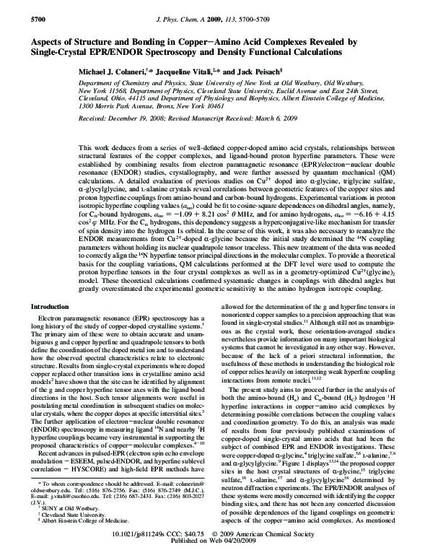
This work deduces from a series of well-defined copper-doped amino acid crystals, relationships between structural features of the copper complexes, and ligand-bound proton hyperfine parameters. These were established by combining results from electron paramagnetic resonance (EPR)/electron−nuclear double resonance (ENDOR) studies, crystallography, and were further assessed by quantum mechanical (QM) calculations. A detailed evaluation of previous studies on Cu2+ doped into α-glycine, triglycine sulfate, α-glycylglycine, and l-alanine crystals reveal correlations between geometric features of the copper sites and proton hyperfine couplings from amino-bound and carbon-bound hydrogens. Experimental variations in proton isotropic hyperfine coupling values (aiso) could be fit to cosine-square dependences on dihedral angles, namely, for Cα-bound hydrogens, aiso = −1.09 + 8.21 cos2 θ MHz, and for amino hydrogens, aiso = −6.16 + 4.15 cos2 φ MHz. For the Cα hydrogens, this dependency suggests a hyperconjugative-like mechanism for transfer of spin density into the hydrogen 1s orbital. In the course of this work, it was also necessary to reanalyze the ENDOR measurements from Cu2+-doped α-glycine because the initial study determined the 14N coupling parameters without holding its nuclear quadrupole tensor traceless. This new treatment of the data was needed to correctly align the 14N hyperfine tensor principal directions in the molecular complex. To provide a theoretical basis for the coupling variations, QM calculations performed at the DFT level were used to compute the proton hyperfine tensors in the four crystal complexes as well as in a geometry-optimized Cu2+(glycine)2 model. These theoretical calculations confirmed systematic changes in couplings with dihedral angles but greatly overestimated the experimental geometric sensitivity to the amino hydrogen isotropic coupling.
